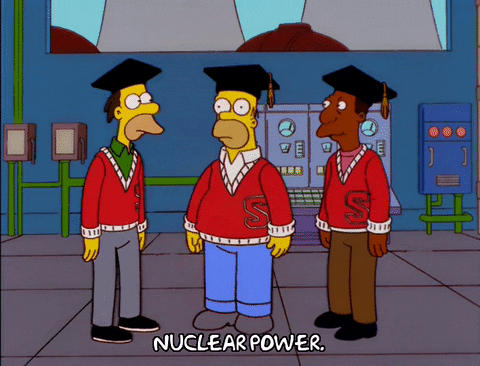| | | | | |  Getty Images | | | Good morning. These days, you can probably discuss generative AI like a pro, and if you can't, you can just ask ChatGPT to summarize it for you. But you might know less about the data centers behind the influential new tech. This necessary infrastructure is a big deal for Big Tech: Nvidia said its data center business grew by 427% last quarter. So, we put together Data Center Brew, a special-edition Sunday newsletter that'll tell you everything you need to know about the big spaces full of servers powering our AI-enabled future, so you can bring something new to the conversation while you're chowing down on a hot dog this afternoon. | | | Jonathan Nackstrand/Getty Images You've heard about data centers but haven't given them much thought. Someone mentions that they work at a data center, so you say "That's cool" before changing the subject. Fear not, we are here to get you plugged in on data centers. Simply put: A data center is the physical location where a company (especially large companies in tech, finance, and healthcare) shelters its IT infrastructure—the servers, data storage drives, and network equipment that allow the business to function. As the company grows, so will the size of the data center it needs and, therefore, the amount of electricity required. What makes an AI data center different? - AI requires more power to carry out its computationally intensive tasks, including machine learning and quickly retrieving answers to myriad queries.
- Generative AI, like the large language models that fuel OpenAI's ChatGPT, can be 100 times larger than other AI models—so they need even more electricity.
That increased processing power comes from graphics processing units, or GPUs, the semiconductor chips manufactured by companies like Nvidia. Those chips reach 176 degrees Fahrenheit when running at maximum power, which requires a creative solution to prevent data centers from overheating. Now you can say "That's cool" and be clever: Keeping piping-hot AI data centers and those GPUs cool requires something stronger than your standard air conditioning systems—liquid cooling. Experts believe full immersion of the IT components into tanks filled with liquid coolants will be the preferred method of keeping everything chill in the coming years.—DL | | | | | | The world has gone digital. An obvious mic drop, sure, but that's why it's absolutely essential for your biz to build a top-notch cybersecurity program. Wanna secure the fort? Say hi to Veeam. Their new white paper draws heavily from the NIST Cybersecurity Framework 2.0. This mouthful of a defense system equips IT and security teams with better standards, guidelines, and risk management practices. Grab this doc to learn how to: - Improve cybersecurity through the NIST Framework 2.0.
- Empower IT to actively participate in the cybersecurity plan.
- Harness Veeam capabilities for your cybersecurity strategy.
Tighten up your cybersecurity. | | | | Star Wars Episode III: Revenge of the Sith/Disney via Giphy The state of AI right now is like one big party…but there's only one bag of Tostitos and the bodega just ran out. The rise of generative AI has rapidly created demand for data centers that require extensive amounts of power to function, and that's a problem, because there isn't enough electricity to run them. For some utility companies, the growing needs of industrial customers like AI data centers, on top of an already strained electrical grid, have limited their ability to provide power to consumers and could affect energy costs for residential customers. And demand isn't slowing down: - The International Energy Agency forecasts that by 2026, data centers globally will use an amount of energy per year equal to Japan's electricity consumption.
- Last year, Dominion Energy, the utility provider for Northern Virginia, which has the largest concentration of data centers in the US, forecast 100% growth in the next 15 years. To meet the demands of planned data centers, it will need several more gigawatts, or enough energy to power over 1 million homes.
A big problem for tech In addition to not knowing what to do with their hands during a keynote, Big Tech CEOs are concerned about the energy grid's ability to keep up with the growth of AI. Because new data centers need long lead times to get connected to power, quickly innovating tech companies are forced to make a choice: 1) Wait it out—and risk falling behind in the AI arms race or 2) find other sources of energy. Many opt for the latter. The result is a rise in natural gas plants (and, in some cases, the revival of coal plants) to meet demand at a time when many of the same tech companies looking for more energy have committed to reducing carbon emissions. Microsoft—the undisputed leader in AI due to its investment in OpenAI—reported that emissions increased 30% from 2020 to 2023, a jump it attributes to the construction of data centers for AI and cloud computing.—CC | | | Francis Scialabba The hottest real estate markets right now don't have views of Central Park or beach access. They feature (mostly) massive, unassuming buildings that slurp up more energy than your parents think you waste by leaving lights on. Data center vacancy rates were as low as 3.7% in 2023, even as the supply in primary markets grew by 26% compared to 2022, according to CBRE. Northern Virginia, nicknamed Data Center Alley, is the largest data center hub in the world. - It handles nearly 70% of global digital traffic.
- Data center rent prices jumped more in the area than in any other hub last year, with rents soaring nearly 42% from 2022 prices.
Other primary markets include Silicon Valley, the tri-state Area (New York, New Jersey, and Pennsylvania), Phoenix, Dallas, Atlanta, Chicago, Portland, Seattle, and LA (and most of these cities' surrounding suburbs). There are also growing secondary hubs like Houston, Denver, and Minneapolis. - A big draw for these clusters is the massive tax incentives offered to attract the facilities, which governments hope will create jobs for locals.
- Factors like climate, electricity costs, and the risk of natural disasters also affect where companies choose to build data centers.
Looking ahead…Microsoft is expected to spend $3 billion to build an AI data center in Racine, Wisconsin, promising 2,000 permanent jobs at the location.—MM | | | | | | Sweet dreams. Beam Dream is a delicious nighttime hot cocoa clinically shown to help you fall asleep, stay asleep, + wake up refreshed. With only 15 calories, all-natural ingredients, and zero added sugars, try guilt-free flavors like Brownie Batter and Salty Chocolate Caramel. For the next 48 hours, get up to 45% off your first order for Memorial Day with code BREW45. | | | | Jahi Chikwendiu/The Washington Post via Getty Images The computer warehouses critical to the AI revolution aren't out of sight, out of mind for everyone. More than half of states offer data center tax incentives to entice tech giants like Google and Meta to set up shop. But the jury's still out on whether they're more of a benefit or a burden for local communities. Ideally…data centers create enough jobs and additional tax revenue to outweigh the income the state forfeits by granting tens or sometimes hundreds of millions of dollars in exemptions. Northern Virginia's Loudoun County, home to the world's highest concentration of data centers, has pulled through a post-pandemic commercial real estate slump thanks to the $600 million in annual tax revenue reaped from the centers. But scrutiny is growing: - Bloomberg reported that one Meta data center in Ohio has received $35 million in property tax breaks, with $54 million more in sales tax breaks on the way in exchange for agreeing to hire at least 50 people.
- Georgia gave $10 million in incentives to X for AI equipment in a data center that didn't expand its small workforce and is only expected to generate $16.5 million in tax revenue over 10 years, per Bloomberg.
Then there's the eyesore of it all Some of the football-field-sized warehouses—and their often-noisy cooling systems—stand 50 feet away from homes in Loudoun County, which is nicknamed Data Center Alley. The power lines that are juicing the facilities require clearing giants' paths through farms and towns across states, prompting some residents to flee, the Washington Post reported. In Loudoun County, community groups worry about infrastructure disrupting local wineries' scenic views and hurting the county's $4 billion tourism industry. The state is working to slap some restrictions on new developments. Elsewhere…officials in Arkansas, Illinois, and Arizona have passed laws limiting or pausing new facility constructions. In Georgia, Gov. Brian Kemp vetoed a bill this month that would've suspended the state's data center sales tax incentives for two years.—ML | | | The Simpsons/Fox via Giphy As AI turns data centers into gigawatt gluttons, split atoms might soon be a staple of their energy diet. Data center operators and their customers are eyeing nuclear power to run their energy-intensive activities in a carbon-neutral fashion. Reactors are attractive sources of wattage for data processing since they tend to have a larger energy capacity than fossil fuel or renewables plants and are often surrounded by vacant land that's just asking for a data center to be built on it. Big Tech goes nuclear Amazon recently bought a nuclear-powered data center campus in Northeastern Pennsylvania that will eventually hoover up over 40% of the energy produced by an on-site reactor. The $650 million deal lets Amazon access the power supply directly from the source instead of competing with all the businesses and homes hooked up to the grid. - Meanwhile, Microsoft hired two nuclear experts this year to spearhead its quest for alternative power sources.
- The company plans to offset the electricity usage at one of its data centers in Virginia through an agreement inked last year with nuclear power plant operator Constellation Energy.
Searching for breakthroughs On top of old-school reactors that split atoms (fission), the data center industry is banking on the experimental tech that smashes them together (fusion). Sam Altman plugged $375 million into nuclear fusion startup Helion, which aims to build breakthrough reactors that would operate on the same energy-producing principle as the sun. It has agreed to start pumping wattage to Microsoft's data centers in 2028. Altman is also invested in experimental mini reactors, similar to the ones on nuclear submarines, being developed by Oklo, which recently went public via a SPAC merger. (Altman is the chairman of Oklo.) Nuclear wins…the clean energy aspirations of data center operators are welcome news for an industry that's been in decline for decades and is often seen as a dusty 20th-century holdover.—SK | | | And now for some fun things that have nothing to do with data centers…  Bake: No-knead focaccia is the perfect bread for a beach sandwich. Bake: No-knead focaccia is the perfect bread for a beach sandwich.
 Buy: Sand won't stick to this lightweight, quick-dry beach towel. Buy: Sand won't stick to this lightweight, quick-dry beach towel.
 Watch: Get your MoviePass ready. Here are 31 movies to look forward to this summer. Watch: Get your MoviePass ready. Here are 31 movies to look forward to this summer.
 Stream: Apple TV+'s new sci-fi thriller, Dark Matter, based on the best-selling novel. Stream: Apple TV+'s new sci-fi thriller, Dark Matter, based on the best-selling novel.
 Drink: Another reason to give Yeti your money…its French press. Drink: Another reason to give Yeti your money…its French press.
 Play: Name countries to get from point A to point B in this geography game. Thanks to Jackie from Waxhaw, NC, for the suggestion. Play: Name countries to get from point A to point B in this geography game. Thanks to Jackie from Waxhaw, NC, for the suggestion.
 Don't overthink it: Finding, hiring, and retaining the best job candidates comes down to having the right processes in place. Grab the How to Hire guide from BambooHR and build yours today.* Don't overthink it: Finding, hiring, and retaining the best job candidates comes down to having the right processes in place. Grab the How to Hire guide from BambooHR and build yours today.*
Do you have a recommendation to share with Brew readers? Submit your best rec here and it may be featured in next week's list. *A message from our sponsor. | | | | |  | |














No comments:
Post a Comment